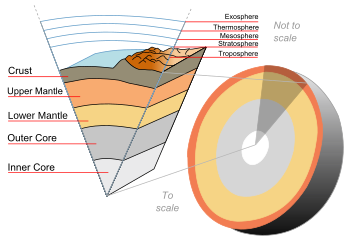Asthenosphere

The asthenosphere (from an invented Greek ἀσθενός a + ''sthenos "without strength") is the region of the Earth between 100 and 200 km below the surface — but perhaps extending as deep as 400 km — that is the weak or "soft" zone in the upper mantle. It lies just below the lithosphere, which is involved in plate movements and isostatic adjustments. It flows a little like hot tar. In spite of its heat, pressures keep it plastic, and it has a relatively low density. Seismic waves, the speed of which decrease with the softness of a medium, pass relatively slowly through the asthenosphere, the cue that originally alerted seismologists to its presence; thus it has been given the name low-velocity zone.
Under the thin oceanic plates the asthenosphere is usually much nearer the seafloor surface, and at mid-ocean ridges it rises to within a few kilometres of the ocean floor.
The upper part of the asthenosphere is believed to be the zone upon which the great rigid and brittle lithospheric plates of the Earth's crust move about. Due to the temperature and pressure conditions in the asthenosphere, rock becomes ductile, moving at rates of deformation measured in cm/yr over lineal distances eventually measuring thousands of kilometers. In this way, it flows like a convection current, radiating heat outward from the Earth's interior. Above the asthenosphere, at the same rate of deformation, rock behaves elastically and, being brittle, can break, causing faults. The rigid lithosphere is thought to "float" or move about on the slowly flowing asthenosphere, creating the movement of crustal plates described by Plate tectonics theory.
Although its presence was suspected as early as 1926, the worldwide occurrence of the asthenosphere was confirmed by analyses of earthquake waves from the Great Chilean Earthquake of May 22, 1960.
External links
References
- Donald L. Turcotte and Gerlad Schubert. Geodynamics, 2nd ed., Cambridge University Press 2001
